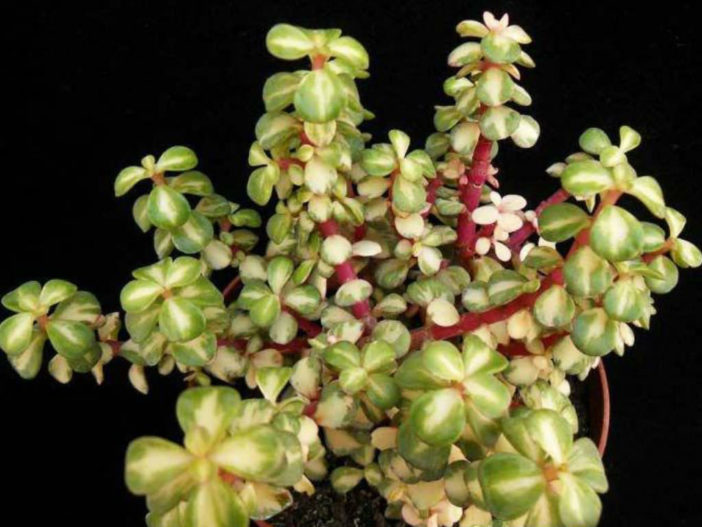Scientific Name
Portulacaria afra 'Medio-picta'
Common Name(s)
Midstripe Rainbow Bush
Synonym(s)
Portulacaria afra 'Kaleidoscope', Portulacaria 'Roulant'
Scientific Classification
Family: Portulacaceae
Subfamily: Portulacarioideae
Genus: Portulacaria
Origin
Portulacaria afra 'Medio-picta' is a cultivar of Portulacaria afra with a variegated filiage.
Description
Portulacaria afra 'Medio-picta', also sold as Portulacaria afra 'Kaleidoscope', is a slow-growing succulent shrub with attractive bright reddish-pink stems and small glossy green leaves with broad white stripes down their middle. The leaves sometimes have little or no green. They are thick, fleshy, broadly obovate, up to 1 inch (2.5 cm) long, and up to 0.6 inches (1.5 cm) wide.
The flowers are small, star-shaped, pink to mauve, and appear in profusion in dense sprays at the end of short lateral branchlets in late spring and early summer.

How to Grow and Care for Portulacaria afra 'Medio-picta'
Light: This plant requires at least 6 hours of direct sunlight daily but can tolerate partial shade. If grown indoors, place it in a sunny window.
Soil: It is very important to have well-draining soil for a healthy plant. While many growers make their own soil mix, commercial soil for succulents with extra perlite or another grit will also work fine.
Hardiness: Portulacaria afra 'Medio-picta' thrives in warm, sunny climates and can tolerate light frost. It grows best in USDA Plant Hardiness Zones 9b to 11b, with average minimum winter temperatures ranging from 25 to 50 °F (-3.9 to 10 °C).
Watering: In spring and fall, water thoroughly and wait until the top of the soil dries out before watering again. Water less during winter when growth slows down significantly. During the summer, when it is usually dormant, water the plant only enough to keep the leaves from shriveling.
Fertilizing: Portulacaria afra 'Medio-picta' is a slow-growing plant that does not need much feeding. However, it will benefit from a small amount of organic fertilizer during the growing season.
Repotting: It is best to repot this plant every 2 to 3 years or when it becomes top-heavy, even though it does not mind being root-bound. Repotting is recommended during summer.
Propagation: Portulacaria afra 'Medio-picta' is started by taking stem cuttings during the growing season.
Toxicity of Portulacaria afra 'Medio-picta'
Portulacaria afra 'Medio-picta' is a non-toxic plant with edible leaves rich in vitamin C and a pleasant sour taste.
Links
- Back to genus Portulacaria
- Succupedia: Browse succulents by Scientific Name, Common Name, Genus, Family, USDA Hardiness Zone, Origin, or cacti by Genus
Photo Gallery
Click on a photo to see a larger version.



